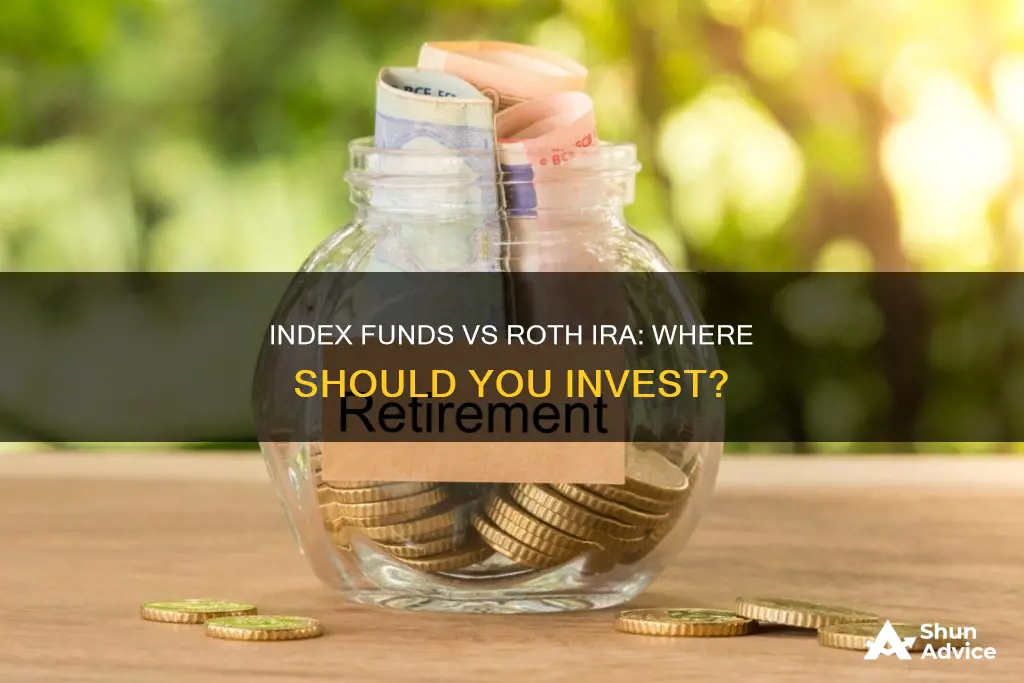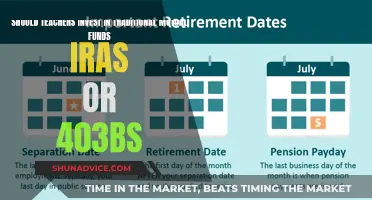
Index funds and Roth IRAs are both powerful tools for building wealth, but they are not mutually exclusive. A Roth IRA is a type of tax-advantaged retirement account, while an index fund is a type of investment that can be held within a Roth IRA. Index funds are a common choice for Roth IRAs due to their automatic portfolio diversification benefits. On the other hand, Roth IRAs offer tax-free growth and withdrawals, making them a popular choice for investors. When considering whether to invest in index funds or a Roth IRA, it is important to understand the differences between these options and how they can work together to achieve your financial goals.
| Characteristics | Values |
|---|---|
| Type of account | A Roth IRA is a type of investment account used to save for retirement. |
| Type of investment | An index fund is a type of investment that tracks a market index. |
| Tax advantages | Contributions to a Roth IRA are not tax-deductible, but withdrawals are tax-free in retirement. |
| Investment options | A Roth IRA can hold various investments, including index funds, individual stocks, and bonds. |
| Diversification | Index funds offer automatic portfolio diversification by investing in a basket of securities that track a market index. |
| Eligibility | Anyone with earned income can contribute to a Roth IRA, subject to income limits. |
| Contribution limits | The maximum contribution limits for a Roth IRA vary by year and age. For example, in 2022, the limit was $6,000 for those under 50 and $7,000 for those 50 and older. |
| Investment costs | Index funds have lower fees than actively managed funds, but they may have investment minimums and expense ratios that impact returns. |
What You'll Learn

US stock index funds
Index funds are a common choice for Roth IRAs and other investment accounts. They are a good option for investors who want to benefit from the growth of the US equity market over time while avoiding the significant trading costs of actively managed funds. Additionally, index funds provide automatic portfolio diversification, as they invest in many different securities, reducing the risk compared to investing in just a couple of securities.
When choosing a US stock index fund, consider the fund's investment minimum and account minimum, as well as the expense ratio and tax-cost ratio, which can affect your investment returns. Also, consider the size and capitalization of the companies the fund tracks, the geography, business sector, and asset type.
Index Funds: How Much Should You Invest?
You may want to see also

US bond index funds
A US bond index fund provides broad exposure to this less risky asset class. An aggregate bond index typically includes exposure to US Treasurys, corporate bonds, and other types of debt securities.
For example, the Fidelity U.S. Bond Index Fund (FXNAX) is a total bond market index fund that offers exposure to the entire bond market, including US Treasury bonds, agency bonds, corporate bonds, and other fixed-income investments. It has an average effective duration of about six years, which means that for each 1% rise or fall in interest rates, the fund's value will move in the opposite direction by about 6%.
Another example is the Vanguard Total Bond Market Index Fund Admiral Shares (VBTLX), which tracks the Bloomberg U.S. Aggregate Float Adjusted Index, a widely followed proxy for the entire US bond market. This fund has an average effective duration of over about six years and offers exposure to Treasury and agency bonds, US government mortgage-backed bonds, and debt from industrial issuers.
When considering US bond index funds, it is important to keep in mind the duration of the fund and the potential impact of interest rate changes on the fund's value. Additionally, while bond funds may not perform as well as stocks over the long term, they can generate meaningful income that is tax-free when held in a Roth IRA.
Private Equity Funds: Impact Investing Strategies Revealed
You may want to see also

Global stock index funds
When it comes to investing, there are many options to consider, such as index funds or a Roth IRA. While both have their benefits, it's important to understand the differences between them to make an informed decision. Here, we will focus specifically on global stock index funds as an investment option and provide a detailed overview.
One example of a global stock index fund is the Vanguard Total World Stock Index Fund Admiral Shares (VTWAX). This fund is designed to offer investors access to all the world's common stock markets and covers securities in both developed and emerging markets. As of January 31, 2022, it held $34.1 billion in assets across 9,350 securities. The fund's top holdings include well-known technology companies like Microsoft, Apple, Amazon, Meta, and Alphabet.
Another option is the Northern Global Sustainability Index Fund (NSRIX), which incorporates environmental, social, and governance (ESG) criteria in its decision-making. This fund uses the MSCI World ESG Leaders Index as a benchmark and includes large and mid-cap companies that meet high standards for social responsibility, ethics, and environmental impact.
When deciding whether to invest in index funds or a Roth IRA, it's essential to consider your financial goals, risk tolerance, and investment horizon. Both options have their benefits, and it may be wise to diversify your investments by utilising both approaches. Consult with a financial advisor to determine the best strategy for your specific needs and circumstances.
The Mindset of Investment Fund Managers: Traits and Insights
You may want to see also

Dividend stock funds
- Reduced Volatility: Dividend-paying companies are often in stable industries, making them less volatile than average funds.
- Reliable Income: Dividend stock funds provide regular income in the form of dividend payments, which can be reinvested to compound returns over time.
- Tax Efficiency: Dividends received in a Roth IRA are not subject to taxes, allowing investors to maximize their returns.
- Lower Risk: Dividend-paying companies are usually financially healthy and have a strong track record of increasing their dividend payouts over time.
When considering dividend stock funds, it is important to evaluate the fund's expense ratio, yield, and risk level. Additionally, investors should diversify their portfolio and consider their overall asset allocation.
- Vanguard High Dividend Yield ETF (VYM): Tracks the FTSE High Dividend Yield Index, excluding REITs, and focuses on high-yielding stocks.
- Vanguard Dividend Appreciation ETF (VIG): Tracks the S&P U.S. Dividend Growers Index, screening for at least 10 years of dividend growth and omitting the top 25% of highest-yielding stocks.
- IShares Core Dividend Growth ETF (DGRO): Targets dividend growth stocks via the Morningstar US Dividend Growth Index, requiring five consecutive years of dividend growth and a positive earnings forecast.
- Schwab U.S. Dividend Equity ETF (SCHD): Tracks the Dow Jones U.S. Dividend 100 Index, focusing on companies with a strong track record of dividend payments and growth.
- T. Rowe Price Dividend Growth Fund (PRDGX): Invests primarily in stocks of large companies with a strong history of dividend payments and expects dividend increases over time.
- Vanguard Dividend Growth Fund (VDIGX): Invests in a diversified portfolio of large-cap and mid-cap companies that are undervalued and have the potential for regular dividend payments.
Smart Mutual Fund Investments: 16K Options
You may want to see also

Value stock funds
Value stocks are also known for their relatively lower volatility compared to growth stocks. They are typically more stable and have lower price fluctuations, making them a good choice for investors seeking steady income and moderate capital appreciation. Additionally, value stocks often issue dividends, providing investors with cash proceeds during the holding period.
When considering value stock funds for your Roth IRA, it's important to remember that they are generally suitable for long-term investment horizons. The power of value stock funds lies in their ability to capitalize on market inefficiencies and undervalued companies, which may take time to fully realize their potential.
- The Vanguard Equity-Income Fund Investor Shares (VEIPX): Focuses on investing in large-cap companies with above-average dividend payouts.
- The ClearBridge Large Cap Value Fund (SAIFX): An actively managed fund seeking capital appreciation and income through a value-focused strategy.
- The Invesco S&P 500 Enhanced Value ETF (SPVU): Tracks the performance of the S&P 500 Enhanced Value Index, investing in stocks with high "value scores".
- The iShares Edge MSCI USA Value Factor ETF (VLUE): Seeks to replicate the performance of the MSCI USA Enhanced Value Index, focusing on large and mid-cap US stocks with value characteristics.
Mutual Fund Investment Strategies: Where to Invest?
You may want to see also
Frequently asked questions
A Roth IRA is a type of tax-advantaged retirement account, while an index fund is a type of investment that tracks a market index. You can invest in index funds through a Roth IRA.
A Roth IRA is a popular choice for investors because withdrawals are tax-free in retirement.
One of the benefits of investing in index funds is automatic portfolio diversification. Index funds are also less expensive than actively managed funds and typically carry less risk than individual stocks.
Some good investments for a Roth IRA include S&P 500 index funds, dividend stock funds, value stock funds, Nasdaq-100 index funds, and target-date funds.
The contribution limit for a Roth IRA is $7,000 for those under 50 years old and $8,000 for those 50 and older.







